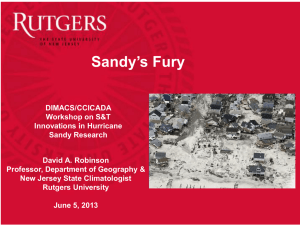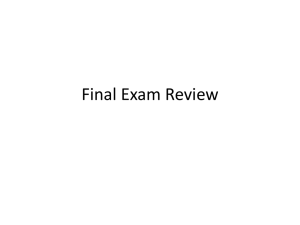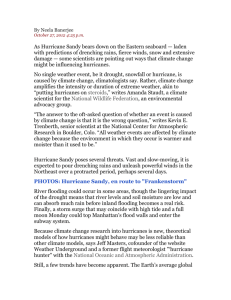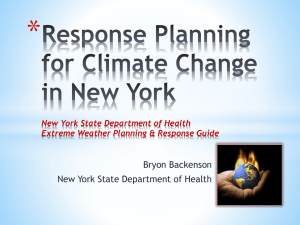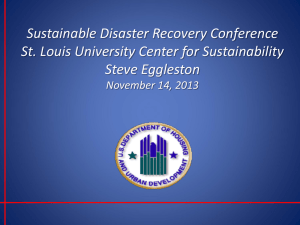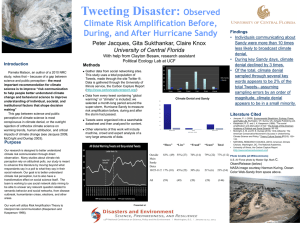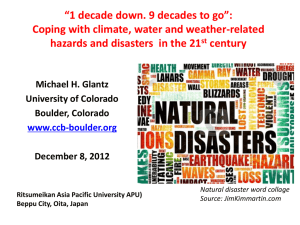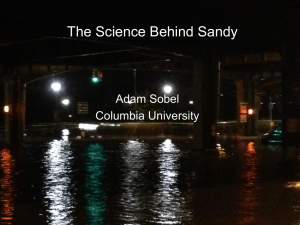Command, Control and Interoperability Center for Advanced Data
advertisement
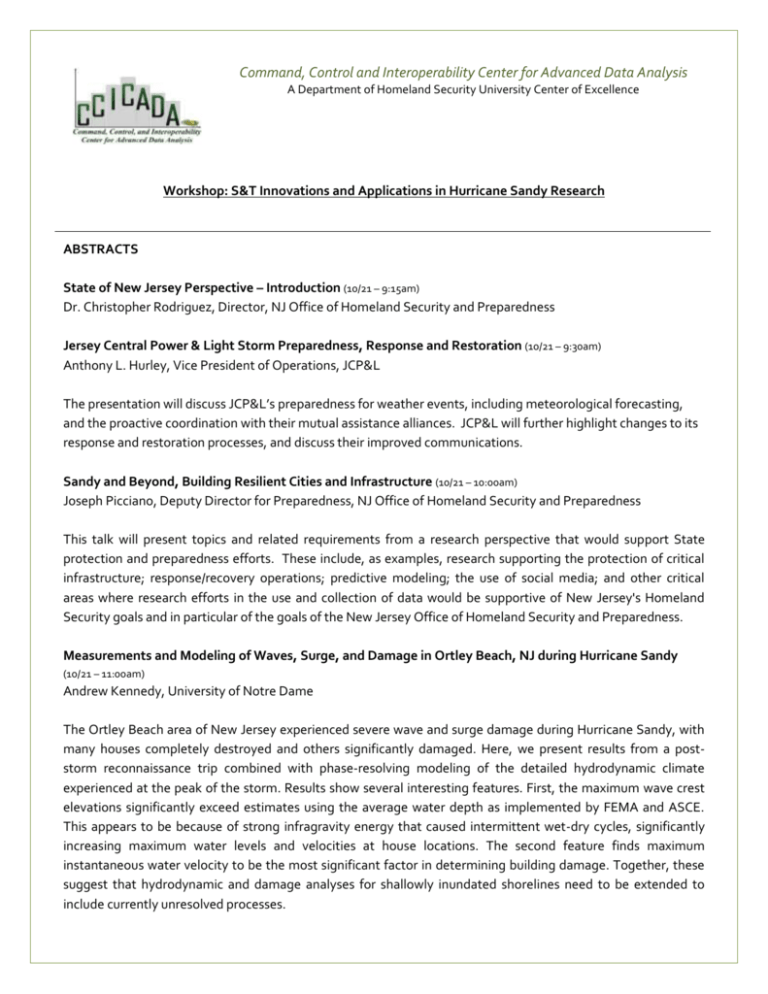
Command, Control and Interoperability Center for Advanced Data Analysis A Department of Homeland Security University Center of Excellence Workshop: S&T Innovations and Applications in Hurricane Sandy Research ABSTRACTS State of New Jersey Perspective – Introduction (10/21 – 9:15am) Dr. Christopher Rodriguez, Director, NJ Office of Homeland Security and Preparedness Jersey Central Power & Light Storm Preparedness, Response and Restoration (10/21 – 9:30am) Anthony L. Hurley, Vice President of Operations, JCP&L The presentation will discuss JCP&L’s preparedness for weather events, including meteorological forecasting, and the proactive coordination with their mutual assistance alliances. JCP&L will further highlight changes to its response and restoration processes, and discuss their improved communications. Sandy and Beyond, Building Resilient Cities and Infrastructure (10/21 – 10:00am) Joseph Picciano, Deputy Director for Preparedness, NJ Office of Homeland Security and Preparedness This talk will present topics and related requirements from a research perspective that would support State protection and preparedness efforts. These include, as examples, research supporting the protection of critical infrastructure; response/recovery operations; predictive modeling; the use of social media; and other critical areas where research efforts in the use and collection of data would be supportive of New Jersey's Homeland Security goals and in particular of the goals of the New Jersey Office of Homeland Security and Preparedness. Measurements and Modeling of Waves, Surge, and Damage in Ortley Beach, NJ during Hurricane Sandy (10/21 – 11:00am) Andrew Kennedy, University of Notre Dame The Ortley Beach area of New Jersey experienced severe wave and surge damage during Hurricane Sandy, with many houses completely destroyed and others significantly damaged. Here, we present results from a poststorm reconnaissance trip combined with phase-resolving modeling of the detailed hydrodynamic climate experienced at the peak of the storm. Results show several interesting features. First, the maximum wave crest elevations significantly exceed estimates using the average water depth as implemented by FEMA and ASCE. This appears to be because of strong infragravity energy that caused intermittent wet-dry cycles, significantly increasing maximum water levels and velocities at house locations. The second feature finds maximum instantaneous water velocity to be the most significant factor in determining building damage. Together, these suggest that hydrodynamic and damage analyses for shallowly inundated shorelines need to be extended to include currently unresolved processes. Command, Control and Interoperability Center for Advanced Data Analysis A Department of Homeland Security University Center of Excellence Comparison of Hurricane Sandy Impacts in Three New Jersey Coastal Communities (10/21 – 11:30am) Katlin Walling, Stevens Institute of Technology Hurricane Sandy made landfall in Brigantine, NJ, on October 29th, 2012 and left many coastal communities in New York and New Jersey devastated. In New Jersey, the damage levels varied significantly between Sandy Hook in the north and Cape May to the south. Some areas, such as Atlantic City survived with only minor damage, while others, such as Ortley Beach and Mantoloking were nearly destroyed. This study reports on data collected under a National Science Foundation (NSF) RAPID grant focusing on Sandy related damage in three of New Jersey’s coastal communities: Sea Girt, Bay Head and Mantoloking. These communities were specifically chosen due to their close proximity to one another and the vast difference in damage each experienced. Sea Girt and Mantoloking bracket the study area, and are located less than 12 km apart, with Bay Head located in between. In comparison to one another, Sea Girt experienced the least amount of damage, Bay Head experienced a moderate amount, while Mantoloking was severely damaged. Under the NSF funding, field data including watermarks, structure damage assessments, and scour information were collected. This data has been used evaluate different factors in an attempt to determine why Sea Girt fared so well, compared to Bay Head and Mantoloking, and why some portions of Mantoloking were nearly completely destroyed, while others were barely impacted. Early observations indicated that the beach profiles and upland elevations played a significant role. Sand dunes in each town provided protection to different degrees; some were large and strong enough to withstand wave action during the storm, while others were too weak. Once the dune line was breached at these weaker locations, high velocity flow channeled through the town causing extensive damage. This occurred in at least two locations in Mantoloking. The community of Bay Head was protected by an existing seawall that was partially buried prior to the storm. As a result, the structures within Bay Head were not subjected to the same wave action or high velocity flow as those in Mantoloking. Sea Girt, which was the least damaged community, benefited from both an extensive beach and dune system and a naturally higher elevation (+15 ft NAVD88, compared to +10 ft NAVD88 in Bay Head and Mantoloking). The data from this study will also be used in several storm models that will further investigate the damaging effects of Sandy along the coasts of New York and New Jersey. In the future, as coastal communities recover and rebuild from similar natural disasters, designers and planners will be able to use the modeling techniques and assessments derived from these measurements to create communities with safe and resilient structures and infrastructure. Environmental Constraints Analysis in Congruence with Design Studies for Reducing Storm Surge and Flooding Risks to New Jersey Coastal Communities (10/21 – 12:00pm) Firas Saleh, Postdoctoral Associate, NJ Institute of Technology Super-storm Sandy destroyed more than 72,000 homes and businesses in New Jersey, killed 34 people and caused more than $62 billion in regional damage and other losses. The New Jersey Department of Environmental Protection (NJDEP) has engaged New Jersey Universities to propose engineering designs to minimize flooding due to future storm surge and other flood events in New Jersey. Three New Jersey water bodies comprised the primary study areas, (1) New York-New Jersey Harbor; (2) Barnegat Bay; and (3) Delaware Bay. Each of these Command, Control and Interoperability Center for Advanced Data Analysis A Department of Homeland Security University Center of Excellence areas are broadly influenced by anthropogenic activities that extend back to colonial times and resulted in varying degrees of habitat loss and alteration. The overarching goal of this study was to review the proposed engineering designs to protect people and property while minimizing, to the extent practical, any negative effects on New Jersey’s coastal ecosystems and the valuable goods and services they contribute to the state’s economy. The first phase of this study consisted of preparing an ecosystem inventory for natural resources (habitats and biota) in each of the three areas being considered for flood mitigation. Resources were summarized broadly for each ecosystem as a whole, and more specifically in the context of ecosystem “boundaries” defined by the proposed flood mitigation alternatives and their likely area of influence. The second phase was to conduct an in-depth analysis of the environmental constraints for the flood mitigation areas under study. This includes potential “cumulative” impacts of all elements of proposed construction in the area including the ‘footprint’ and the secondary effects of the project(s) on hydrodynamics, sediment dynamics, mobilization of potential contaminants, and migratory pathways and spawning areas of dominant taxa. Examples of the methods being used to assess environmental effects of the proposed engineering solutions on natural resources will be presented. Family Structures, Relationships, and Relocation Decisions after Hurricane Sandy (10/21 – 1:30pm) Ali Nejat, Texas Tech University This study examines how family bonds affect rebuilding/relocating decisions after hurricanes. The sample was from a survey of 129 individuals recruited from Staten Island after it was seriously damaged by the 2012 Hurricane Sandy. Multinomial logistic regression was used to investigate how respondents’ family structures before Sandy and whether their relationships improved with family members after Sandy influenced their plans for rebuilding/repairing their homes or relocating to other places. Multinomial logistic regression was also used to examine whether those factors affected respondents’ suggestions to a vignette family concerning rebuilding and relocating. Results indicated that respondents who lived with family members before Sandy were less likely to plan for relocating than those who lived alone. More detailed examination showed that this effect was driven by those who improved on their relationships with family members; those who did not improve on their family relationships were not significantly different from those who lived alone concerning rebuilding/relocating planning. Those who improved on their relationships with family members were also less likely to suggest the vignette family relocate. This study supports the general hypothesis that family bonds reduce the endorsement for relocating and provides empirical evidence that family mechanisms are important for the rebuilding/relocating decision making. Network Improvisation in Emergency Response: An Application to Debris Removal Operations (10/21 – 2:00pm) David Mendonca, Rensselaer Polytechnic Institute The emergent characteristics of disasters—including unforeseen contingencies and the unexpected behaviors of community members exposed to those contingencies—can sometimes require the spontaneous creation of new organizations (and new organizational forms) to undertake response activities. Less well understood is the coevolution of work processes within these organizations. This work uses a variety of data sources from Hurricane Sandy to explore the simultaneous co-evolution of the organization and work processes associated with the Command, Control and Interoperability Center for Advanced Data Analysis A Department of Homeland Security University Center of Excellence removal of debris in the State of New York. It illustrates how organizational records (such as meeting minutes) and field data (such as registers of work performed) may be combined in a common representational format (here, a network of networks) to analyze these highly improvisational processes. The results of this work, particularly when viewed in light of projections for future storms in this region, strongly suggest that debris management plans—and the organizations responsible for executing them—will need to be revised in order to address the particular demands of high density urban areas. (This material is based upon work supported by U.S. National Science Foundation Grants CMMI-1363513 and CMMI-1313589) Collection of Data of Flood and Damage in New York City during Hurricane Sandy (10/21 – 2:30pm) Hansong Tang, CUNY City College Hurricane Sandy impacted metro NYC with severe winds and floods, and it caused various damages. Sandy is a catastrophic but small probability event, and collection of its data will provide a precious as well as an indispensable platform for risk study and prediction of future events. For this purpose, shortly after the pass of Sandy, we collected and documented field data on floods and damages in metro NYC and made preliminary analysis on them. The collected data come from Rockaway Park, Long Beach, etc. of NYC and other places. In this presentation, we will report our collected data, including those obtained after the last workshop at Rutgers in 2013, their documentation, and present a preliminary effort on model development for simulation of hydrodynamic impact on structures during the Sandy event. NJ Transit - Superstorm Sandy Recovery and Resilience Program (10/21 – 3:30pm) Eric R. Daleo, Director, Superstorm Sandy Recovery and Resilience Program, NJ Transit Component-based vulnerability analysis of storm surge damage to residential structures from Hurricane Sandy (10/21 – 4:00pm) Adam Hatzikyriakou, Princeton University In this study, storm surge damage to critical structural components of coastal structures is assessed and used to statistically analyze structural vulnerability. Following Hurricane Sandy, physical damage to 376 structures in Ortley Beach, New Jersey was documented using a manual ground-based survey and a mobile LiDAR survey. Using photography of damage from the manual survey, physical damage to structural components is assessed according to failure mechanism, construction type and material. General observations include widespread failure of closed foundations from large lateral loads, vulnerability of exterior walls to impact from waterborne debris and the poor performance of lap siding. Larger-scale effects such as dune erosion and structural shielding likewise contributed to different storm surge environments and magnitude of surge damage. Using the mobile LiDAR survey, a method for rapidly assessing foundation damage by detecting changes in a structure’s location before and after the event is proposed and found to reliably assess severely damaged foundations. Logistic regression is used to develop vulnerability curves giving the probability of component failure in different surge environments. Aggregating data to reduce statistical uncertainty significantly underestimates vulnerability in areas with dune failure, while overestimating vulnerability in shielded areas. A multivariate analysis indicates that ground and house elevations are likewise strong predictors of surge damage. Command, Control and Interoperability Center for Advanced Data Analysis A Department of Homeland Security University Center of Excellence Improving Coastal Resilience and Environmental Sustainability with Big 3D Disaster Data: Challenges and Opportunities (10/21 – 4:30pm) Jie Gong, Rutgers University A growing portfolio of remote sensing technologies has been used during natural disasters to collect essential data to support disaster response and recovery. This presentation discusses the challenges and opportunities in integrating, processing, and analyzing the growing volume and variety of remotely sensed data collected during large-scale natural disasters to support more resource-efficient disaster recovery. More specifically, this presentation will discuss several critical issues and needs learned from Hurricane Sandy and how LIDAR collections made on different platforms including airplanes and moving vehicles immediately post Sandy can be used to address these issues such as rapid costal structure damage assessment, evidence-based community recovery and rebuilding, debris and waste removal, risk communication, and protection and risk mitigation for critical infrastructure systems. Future technology developments and applications will also be discussed. Green and Adaptive Flood Risk Reduction Strategies for Rebuilding in the Aftermath of Super Storm Sandy (10/21 – 5:00pm) Bertrand Byrne & Qizhong (George) Guo, Rutgers University This presentation will review findings and recommendations obtained through the flood risk reduction strategy development effort sponsored by the New Jersey Governor’s Office of Recovery and Rebuilding and the New Jersey Department of Environmental Protection. Five coastal waters across the State and their surrounding communities were covered, namely, from north to south, Hackensack River, Hudson River, Arthur Kill, Barnegat Bay and Delaware Bay. All three sources of the threat (the flood water), namely, local rainwater, upstream riverine flow, and downstream coastal water, and various levels (recurrence intervals) of the threat and their future changes were considered in developing the strategies. Innovative technologies that are green and adaptive were emphasized in the effort, and they include stormwater green infrastructure, green water pumps, extendable floodwalls, causeway with operable flood gates, and salt marsh restoration. Health Impact Assessment: An Institutional Mechanism for Improving Disaster Recovery (10/22 –9:00am) James K. Mitchell, Department of Geography, Rutgers University Local residents’ experiences of Sandy and the formal disaster recovery system are only weakly connected to that system. NFIP (National Flood Insurance Program) guidance information that plays a major role in shaping post--Sandy rebuilding and recovery efforts do not take account of many flood-¬forcing factors that are known by and of concern to, residents of impacted communities. Nor is the recovery process sensitive to the complex web of rebuilding and redevelopment decisions that residents are called upon to make in the months after the disaster. The innovative tool of Health Impact Assessment offers opportunities to redress these shortcomings and achieve more integrated and sustainable recovery outcomes. Clifton R. Lacy, MD., Professor & Director of the University Center for Disaster Preparedness and Emergency Response and of the Rutgers Institute for Emergency Preparedness and Homeland Security, Rutgers, the State University of NJ (10/22 – 9:30am) Command, Control and Interoperability Center for Advanced Data Analysis A Department of Homeland Security University Center of Excellence The Recovery and Adaptability of Vital Public Transit Services Following Hurricane Sandy and Implications for Other Extreme Events (10/22 – 10:00 am) Rae Zimmerman, New York University The concept of recovery goes beyond returning to some original state to the redesign for resilience to enable a system to withstand impacts from future extreme events. This research provides both an engineering and social perspective on public transit recovery following Hurricane Sandy with implications for other similar weatherrelated hazards and services. It is drawn from the analysis of subway line and station ridership recovery in New York City that reflects the physical system and the users respectively, suggesting a number of factors that contributed to the recovery rate. Using coarse GPS data to quantify city-scale transportation system resilience to extreme events (10/22 – 11:00am) Daniel Work, University of Illinois at Urbana-Champaign This article proposes a method to quantitatively measure the resilience of transportation systems using GPS data from taxis. The granularity of the GPS data necessary for this analysis is relatively coarse; it only requires coordinates for the beginning and end of trips, the metered distance, and the total travel time. The method works by computing the historical distribution of pace (normalized travel times) between various regions of a city and measuring the pace deviations during an unusual event. This method is applied to a dataset of nearly 700 million taxi trips in New York City, which is used to analyze the transportation infrastructure resilience to Hurricane Sandy. The analysis indicates that Hurricane Sandy impacted track conditions for more than five days, and caused a peak delay of two minutes per mile. Practically, it identifies that the evacuation caused only minor disruptions, but significant delays were encountered during the post-disaster reentry process. Since the implementation of this method is very efficient, it could potentially be used as an online monitoring tool, representing a first step toward quantifying city scale resilience with coarse GPS data. Rutgers University Hurricane Sandy Task Force Report (10/22 – 11:30am) Steven Keleman, Rutgers University Office of Emergency Management As part of its post-Sandy analysis, Rutgers University convened a Task Force charge with the review of the impact of Hurricane Sandy on university operations, the overall success and challenges related to the university’s response and recovery and the areas that could help prepare the university community for any such future events. The Task Force developed and released its ‘Hurricane Sandy Task Force Report’ in summary of its findings in the areas listed above. This talk will cover the Task Force’s ten overarching recommendations focusing on lessons learned and how the university can use this information to enhance preparedness. Restoration Interdependencies and the Value of Information-Sharing in Interdependent Infrastructure Restoration (10/22 – 12:00pm) Thomas Sharkey, Rensselaer Polytechnic Institute Command, Control and Interoperability Center for Advanced Data Analysis A Department of Homeland Security University Center of Excellence We examine the new concept of restoration interdependencies that arise in interdependent infrastructure restoration (IIR) and how information-sharing can help mitigate their impact on the effectiveness of IIR efforts. Restoration interdependencies occur whenever a restoration task in one infrastructure is impacted by a restoration task, or lack thereof, in another infrastructure. These interdependencies can impact the timeline of the restoration efforts an infrastructure due to a lack of information about other infrastructures’ restoration efforts. We present new scheduling models to capture restoration interdependencies and the role of decentralized decision-making in IIR efforts. Computational testing, on damage instances motivated by Hurricane Sandy, indicate that information-sharing between infrastructures can greatly reduce the ‘price’ of decentralized decision-making in IIR efforts.
